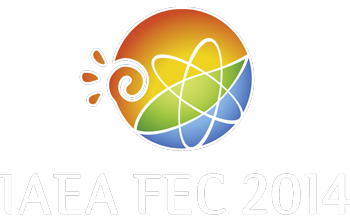Speaker
Mrs
Cristina Mazzotta
(ENEA)
Description
The density profile peaking produced by Ne-gas puffing was studied in in different L-mode plasma scenarios during recent experimental campaigns on FTU. In fact an stable radiative edge seeded with light impurities has beneficial effects and provokes density peaking without any undesirable central impurity accumulation [1,2]; on the other hand, a too large amount of impurities can lead to a disruptive MHD activity. In order to maintain the positive effect of the edge radiation it is important to fix the conditions of a strong increase of particle confinement while minimizing the amount of impurities needed.
On FTU the Ne injection causes a spontaneous increase of the line average density by a factor 2 in the absence of Deuterium gas puffing. A Ne doped discharge is compared with a complementary one that reaches the same density by D gas puffing in the absence of Neon injection. The comparison shows a more peaked density for the Ne doped discharge. A qualitative estimate from UV spectroscopy measurements indicates that the density behavior cannot be attributed simply to the stripped electrons from the puffed Ne, but a modification of particle transport should be invoked in order to explain the spontaneous rise and the higher peaking.
The recent experiments were devoted to characterize the plasma response to Ne injection at different densities and plasma currents. The principal results are: i) if density before the Ne puff is increased, the same injected impurity amount induces an abrupt density increase that rapidly ends in a disruption; ii) as the plasma current rises a less steep increase of the density is observed, and more D gas is necessary to obtain the same MHD activity that leads to the disruption.
Finally, the observed density peaking is analyzed in terms of electron diffusion coefficients D and pinch velocity U. In the framework of a simple particle transport model [3], the presence of an inward pinch is confirmed. A micro-stability analysis will be performed to investigate the role of the ion and electron gradient driven modes on particle transport.
[1] G. Telesca et al. 2000 Nucl. Fusion 40 1845
[2] A. Messiaen et al. 1996 Phys. Rev. Lett. 77 2487
[3] V. Zanza et al 1996 Nucl. Fusion 36 825
| Country or International Organisation | Italy |
|---|---|
| Paper Number | EX/P2-52 |
Author
Mrs
Cristina Mazzotta
(ENEA)
Co-authors
Mr
Antonio Botrugno
(ENEA - Unità Tecnica Fusione)
Mr
Basilio Esposito
(ENEA)
Dr
Carlo Sozzi
(Istituto di Fisica del Plasma CNR, Associazione EURATOM-ENEA)
Mr
Daniele Marocco
(ENEA)
Dr
Gianluca Pucella
(ENEA, Associazione Euratom-ENEA)
Dr
Giovanni Artaserse
(ENEA)
Mrs
Lory Gabellieri
(ENEA)
Mr
Massimo Marinucci
(ENEA)
Mr
Onofrio Tudisco
(ENEA)
Dr
Roberto Cesario
(ENEA FRASCATI)

